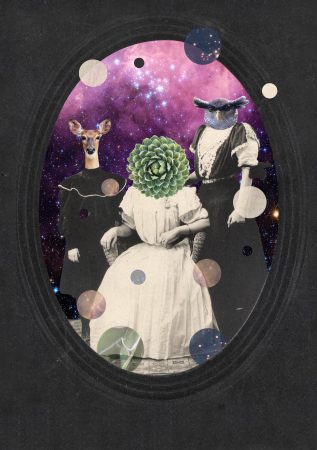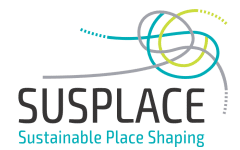
March 2017
I enter a dark room, two screens on both sides display images of large telescopes and green forests, in the front a black screen with white text. A story is being told. I’ve seen this before, in various art museums and galleries I first think to myself. But there is something in the setting, the atmosphere that invites me to sit down and find out what the story being told is about. The storyteller is describing the Arecibo Observatory in Puerto Rico, which holds the world’s largest telescope. The telescope acts as an ear and a mouth. From this site signals have been sent out into the galaxy, with the intention to find intelligent life outside earth. Now a response is awaited. It’s only after a while I realise that the storyteller is a parrot, telling the exhibition visitors about the nature of human beings and about humans’ relationship to life around them, from her own perspective. It turns out this story and this installation is nothing like the ones I’ve seen and heard before. The installation is an art work by the artist duo Allora & Calzadilla titled The Great Silence (2014)[i]. The storyteller-parrot reflects upon the human desire to find intelligent life in space, when in fact parrots, now threatened by distinction, share several features with humans. They too communicate, give each other names and have learned not only to imitate humans’ way of communicating, but also to understand the concepts of colour and shape. It took a long time for humans to consider the possibility that parrots in fact could be intelligent, “Humans like to think they’re unique.” the parrot reflects.
The installation was one of the main art works at the Making Nature exhibition at the Wellcome Collection in London. The exhibition discussed our (humans’) relationship to animals and nature around us. Our need to order, collect and display, to observe and to understand. But who are we to put ourselves beyond nature? As I walk through the exhibition space the lyrics I change shapes just to hide in this place. But I’m still, I’m still an animal start playing in my head. These lyrics are from a song called Animal by Mike Snow. The exhibition also reminds me of a project I’ve been following for a while, Parliament of Things by Partizan Publik. I check the latest updates of the project and discover that they will have an installation as part of the Holland festival in Amsterdam, June 2017.
June 2017
Luckily I had plans to prepare for my upcoming secondment in the Netherlands so a few months after visiting the Making Nature exhibition I get the opportunity to visit the installation Parliament of Things. Democracy in the Anthropocene. The installation builds upon the ideas of French philosopher Bruno Latour[ii], and envisions “a democratic space for the Age of the Anthropocene”. Questions such as “How can we give a thing, plant or animal a voice?” “Can we imagine politics beyond men?” “Do we need to take holidays from being human?” are being posed.
The exhibition Making Nature and the installation Parliament of Things both trigger questions about our relationship with nature, how we see ourselves in relation to other beings and poses questions about whether things could be different if we ceased to place ourselves in the centre of everything we are planning, designing and creating. Having a background in design I have previously been very interested in human centred and collaborative design. But when you start thinking about it, why would you even call something Human Centred Design? So far we have almost without exception been designing for the human system. However, one can question to what extent this has been successful, taking into account that a discussion for the importance of taking real human needs into consideration when designing is still flourishing. This makes me wonder what it would mean to design in a less human centred manner, to plan for a future where democracy is understood as something taking all beings into consideration? Where co-design would include more than humans to ensure not only human perspectives are being considered.
August 31st 2017
In the Action Hub: Arts-based methods for transformative design[iii] organised by a group of SUSPLACE researchers[iv] for the Transformations 2017 conference in Dundee, one of the metaphors applied for perspective transformation was referred to as More Than Human. Participants of the workshop engaged in exercises aimed at creating empathy towards more than human species by looking at specific cases from the perspective of the Arctic Fox, the Bear, the Birch Forrest and the Owl, to name a few. The birch forest told participants about their interconnected underground networks, through which information and nutrition are shared. The bear presented herself as being shy and difficult to spot, while also, just like humans, being a shaper of ecosystems through her actions and movements. In the same manner, human centred design has aimed at building empathy for (human) users through various methods, perhaps it’s now time we start expanding our discussion of co-design and co-creation from collaboration among humans towards a way of planning and designing that is less human focused and more inclusive towards all species?
[i] A Vimeo version of The Great Silence (2014) by Allora & Calzadilla can be found here: https://vimeo.com/195588827
[ii] A short introduction to Latour’s work on The Parliament Of Things website: http://theparliamentofthings.org/into-latour/
[iii] A more thorough description including reflections of the workshop will follow.
[iv] The Workshop was designed and organised by Kelli Pearson, Sara Grenni, Angela Moriggi, Anke de Vrieze, Siri Pisters and Malin Bäckman. Marta Nieto provided significant input by facilitating one of the 5 tables during the workshop. The session was supported by Ina Horlings, Katriina Soini and Dirk Roep who in addition to support acted as participant observers.
